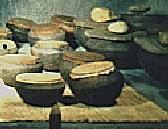
Ceramic pots used as storage,
Cahokia Mounds Museum.
Much like those in our own cupboards, the primary function of Powell Plain plates and bowls was to hold part of an individual's meal or help in meal preparation. The context in which plates, bowls, and jars are found, in or near residential facilities, supports this interpretation. In contrast, Ramey-Incised plates and bowls, and effigy bowls are typically found in or near religious or civic structures indicating a specialized use in ritual consumption or ceremonial preparation of foods for civic or religious feasting. The remains of a hallucinogenic plant and an abundance of Ramey-Incised sherds associated with a temple structure at the BBB Motor site and, suggest that some Ramey-Incised vessels were used for plant preparation, presumably for ritualistic or religious consumption.